Business Communication Analysis: Strategies for Success in Business
VerifiedAdded on 2020/03/02
|7
|2043
|33
Report
AI Summary
This report delves into the critical aspects of business communication within an organizational setting. It begins by highlighting the evolution of communication technologies and their impact on business practices, emphasizing the shift from traditional methods to modern digital tools like email and the internet. The report then explores the potential pitfalls of communication breakdowns, using a real-world case study to illustrate how failures in communication, such as emails ending up in spam folders, can lead to significant operational and financial setbacks. It underscores the importance of having multiple communication channels and the need for proactive follow-up to ensure messages are received and understood. Furthermore, the report discusses the benefits of dialogic communication, where all parties have an equal voice, fostering open dialogue, and encouraging active listening to build strong relationships, enhance employee engagement, and improve conflict resolution. It also examines the significance of intercultural communication, emphasizing the need for open communication, respecting diverse viewpoints, and adapting management practices to promote collaboration and idea-sharing across different cultural backgrounds. The report concludes by advocating for a culture of open communication and dialogue as essential for organizational success, employee value, and high performance.
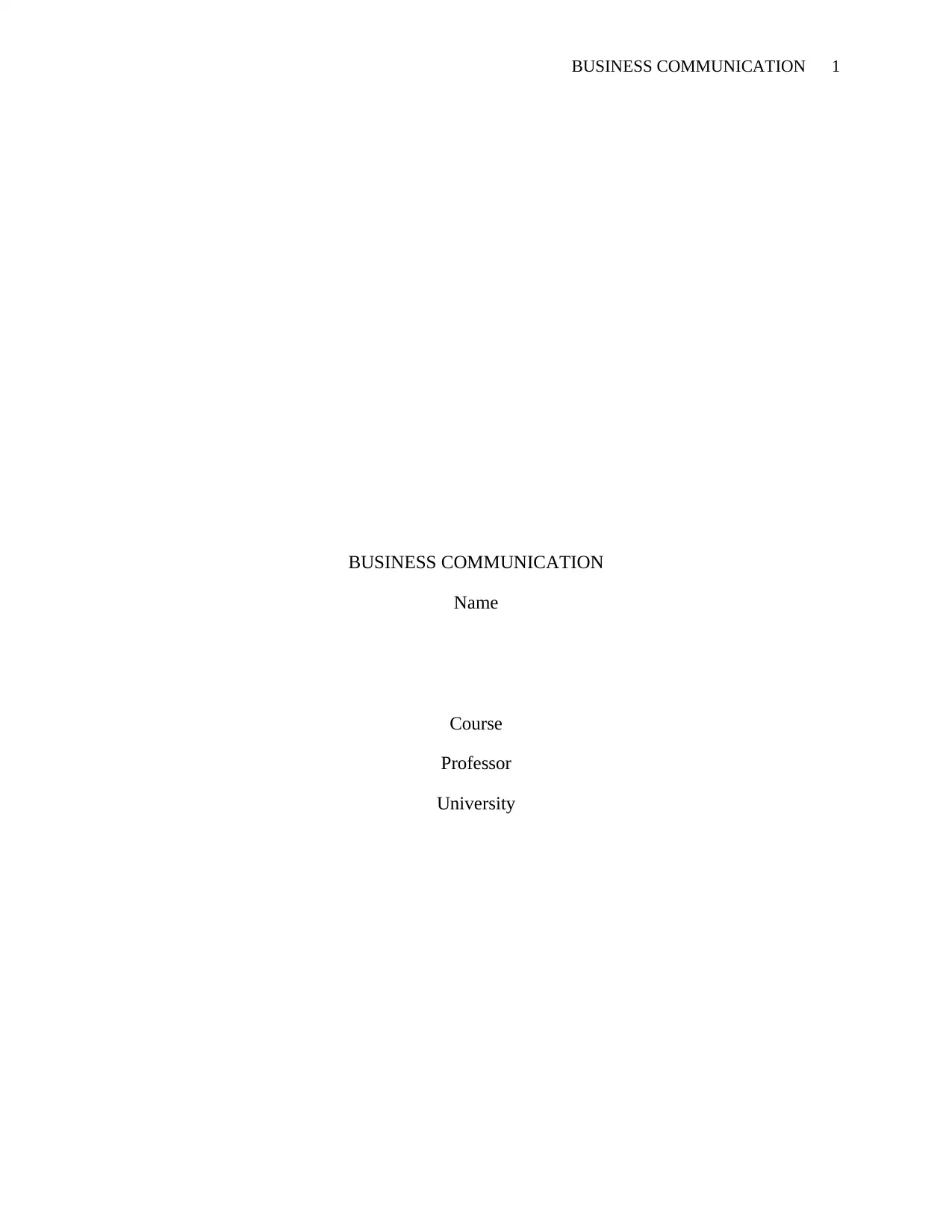
BUSINESS COMMUNICATION 1
BUSINESS COMMUNICATION
Name
Course
Professor
University
BUSINESS COMMUNICATION
Name
Course
Professor
University
Paraphrase This Document
Need a fresh take? Get an instant paraphrase of this document with our AI Paraphraser
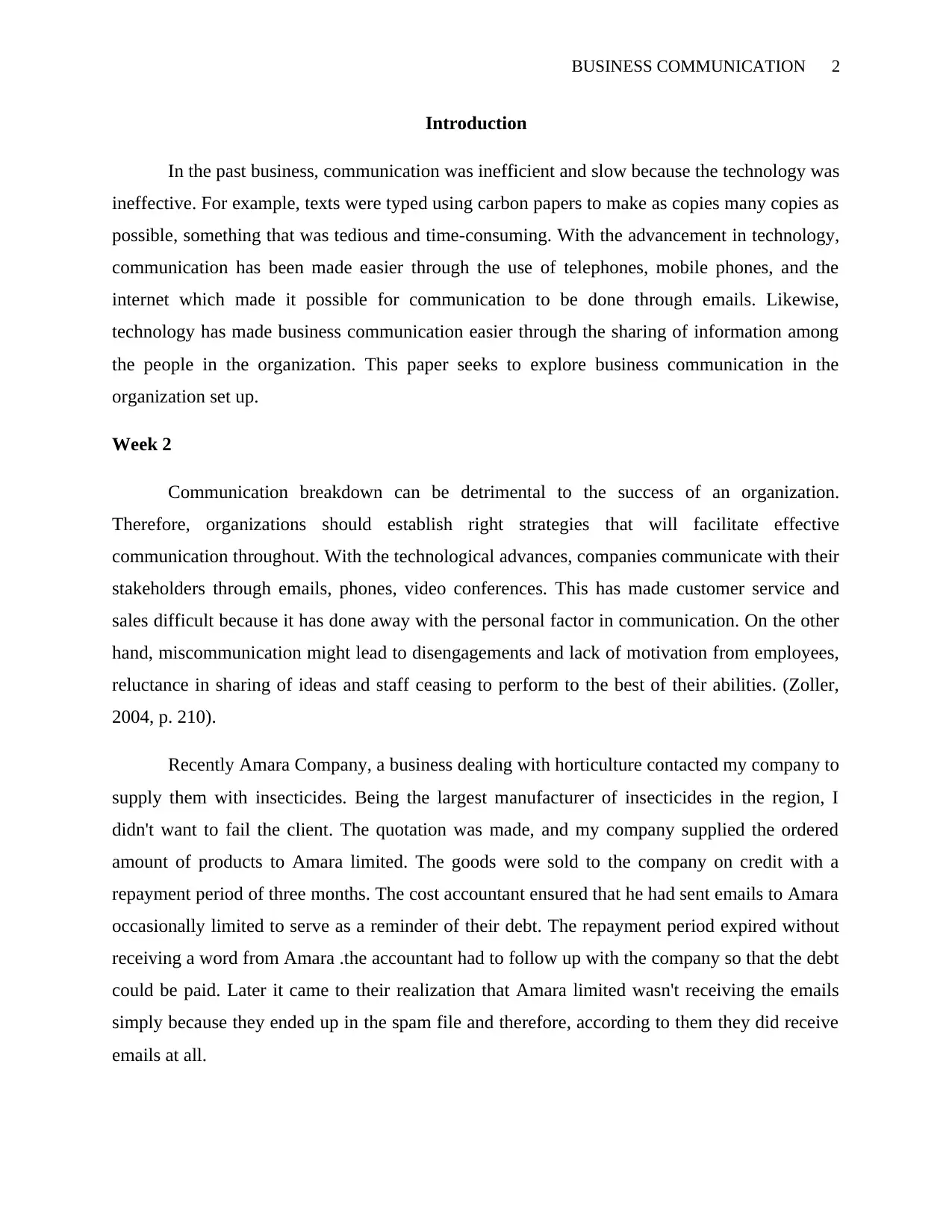
BUSINESS COMMUNICATION 2
Introduction
In the past business, communication was inefficient and slow because the technology was
ineffective. For example, texts were typed using carbon papers to make as copies many copies as
possible, something that was tedious and time-consuming. With the advancement in technology,
communication has been made easier through the use of telephones, mobile phones, and the
internet which made it possible for communication to be done through emails. Likewise,
technology has made business communication easier through the sharing of information among
the people in the organization. This paper seeks to explore business communication in the
organization set up.
Week 2
Communication breakdown can be detrimental to the success of an organization.
Therefore, organizations should establish right strategies that will facilitate effective
communication throughout. With the technological advances, companies communicate with their
stakeholders through emails, phones, video conferences. This has made customer service and
sales difficult because it has done away with the personal factor in communication. On the other
hand, miscommunication might lead to disengagements and lack of motivation from employees,
reluctance in sharing of ideas and staff ceasing to perform to the best of their abilities. (Zoller,
2004, p. 210).
Recently Amara Company, a business dealing with horticulture contacted my company to
supply them with insecticides. Being the largest manufacturer of insecticides in the region, I
didn't want to fail the client. The quotation was made, and my company supplied the ordered
amount of products to Amara limited. The goods were sold to the company on credit with a
repayment period of three months. The cost accountant ensured that he had sent emails to Amara
occasionally limited to serve as a reminder of their debt. The repayment period expired without
receiving a word from Amara .the accountant had to follow up with the company so that the debt
could be paid. Later it came to their realization that Amara limited wasn't receiving the emails
simply because they ended up in the spam file and therefore, according to them they did receive
emails at all.
Introduction
In the past business, communication was inefficient and slow because the technology was
ineffective. For example, texts were typed using carbon papers to make as copies many copies as
possible, something that was tedious and time-consuming. With the advancement in technology,
communication has been made easier through the use of telephones, mobile phones, and the
internet which made it possible for communication to be done through emails. Likewise,
technology has made business communication easier through the sharing of information among
the people in the organization. This paper seeks to explore business communication in the
organization set up.
Week 2
Communication breakdown can be detrimental to the success of an organization.
Therefore, organizations should establish right strategies that will facilitate effective
communication throughout. With the technological advances, companies communicate with their
stakeholders through emails, phones, video conferences. This has made customer service and
sales difficult because it has done away with the personal factor in communication. On the other
hand, miscommunication might lead to disengagements and lack of motivation from employees,
reluctance in sharing of ideas and staff ceasing to perform to the best of their abilities. (Zoller,
2004, p. 210).
Recently Amara Company, a business dealing with horticulture contacted my company to
supply them with insecticides. Being the largest manufacturer of insecticides in the region, I
didn't want to fail the client. The quotation was made, and my company supplied the ordered
amount of products to Amara limited. The goods were sold to the company on credit with a
repayment period of three months. The cost accountant ensured that he had sent emails to Amara
occasionally limited to serve as a reminder of their debt. The repayment period expired without
receiving a word from Amara .the accountant had to follow up with the company so that the debt
could be paid. Later it came to their realization that Amara limited wasn't receiving the emails
simply because they ended up in the spam file and therefore, according to them they did receive
emails at all.
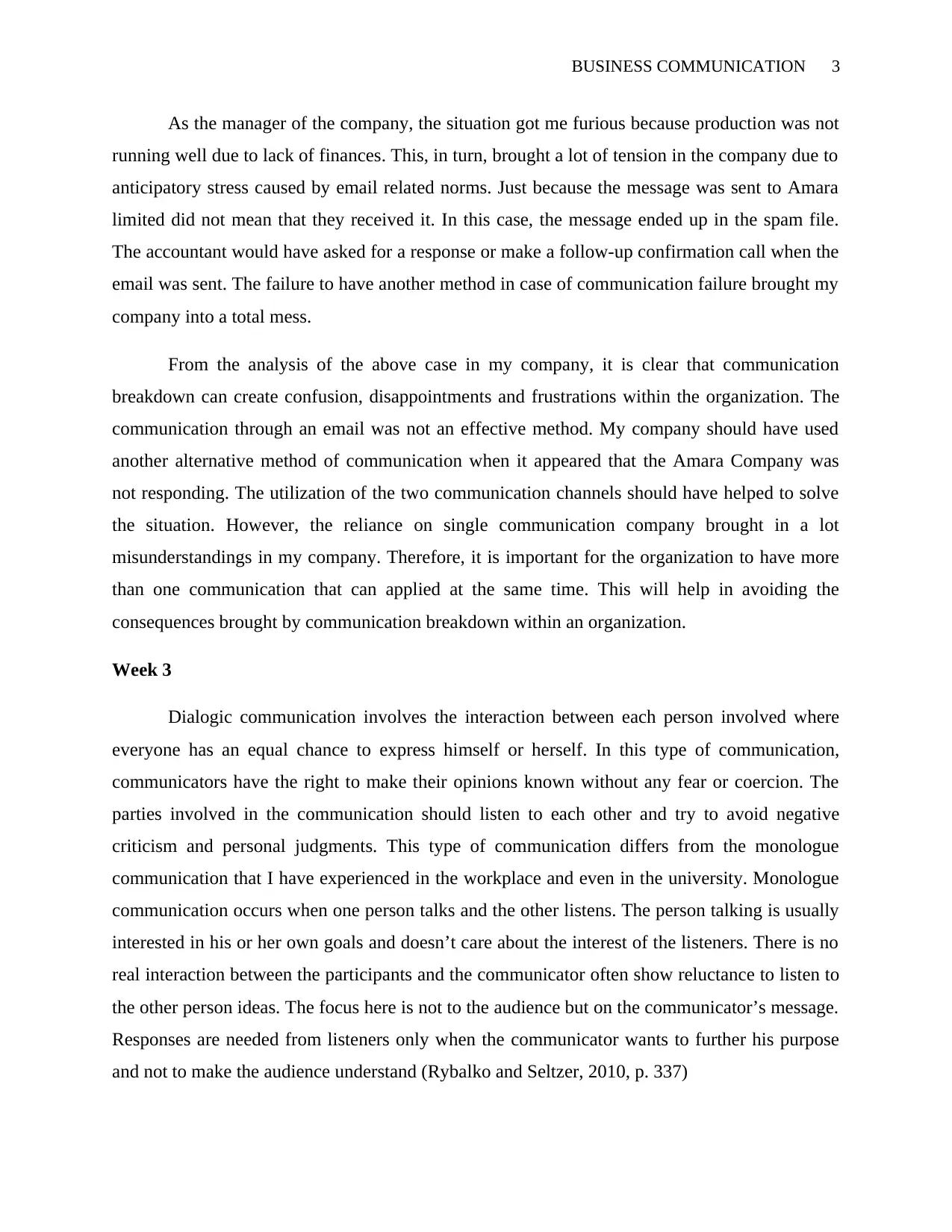
BUSINESS COMMUNICATION 3
As the manager of the company, the situation got me furious because production was not
running well due to lack of finances. This, in turn, brought a lot of tension in the company due to
anticipatory stress caused by email related norms. Just because the message was sent to Amara
limited did not mean that they received it. In this case, the message ended up in the spam file.
The accountant would have asked for a response or make a follow-up confirmation call when the
email was sent. The failure to have another method in case of communication failure brought my
company into a total mess.
From the analysis of the above case in my company, it is clear that communication
breakdown can create confusion, disappointments and frustrations within the organization. The
communication through an email was not an effective method. My company should have used
another alternative method of communication when it appeared that the Amara Company was
not responding. The utilization of the two communication channels should have helped to solve
the situation. However, the reliance on single communication company brought in a lot
misunderstandings in my company. Therefore, it is important for the organization to have more
than one communication that can applied at the same time. This will help in avoiding the
consequences brought by communication breakdown within an organization.
Week 3
Dialogic communication involves the interaction between each person involved where
everyone has an equal chance to express himself or herself. In this type of communication,
communicators have the right to make their opinions known without any fear or coercion. The
parties involved in the communication should listen to each other and try to avoid negative
criticism and personal judgments. This type of communication differs from the monologue
communication that I have experienced in the workplace and even in the university. Monologue
communication occurs when one person talks and the other listens. The person talking is usually
interested in his or her own goals and doesn’t care about the interest of the listeners. There is no
real interaction between the participants and the communicator often show reluctance to listen to
the other person ideas. The focus here is not to the audience but on the communicator’s message.
Responses are needed from listeners only when the communicator wants to further his purpose
and not to make the audience understand (Rybalko and Seltzer, 2010, p. 337)
As the manager of the company, the situation got me furious because production was not
running well due to lack of finances. This, in turn, brought a lot of tension in the company due to
anticipatory stress caused by email related norms. Just because the message was sent to Amara
limited did not mean that they received it. In this case, the message ended up in the spam file.
The accountant would have asked for a response or make a follow-up confirmation call when the
email was sent. The failure to have another method in case of communication failure brought my
company into a total mess.
From the analysis of the above case in my company, it is clear that communication
breakdown can create confusion, disappointments and frustrations within the organization. The
communication through an email was not an effective method. My company should have used
another alternative method of communication when it appeared that the Amara Company was
not responding. The utilization of the two communication channels should have helped to solve
the situation. However, the reliance on single communication company brought in a lot
misunderstandings in my company. Therefore, it is important for the organization to have more
than one communication that can applied at the same time. This will help in avoiding the
consequences brought by communication breakdown within an organization.
Week 3
Dialogic communication involves the interaction between each person involved where
everyone has an equal chance to express himself or herself. In this type of communication,
communicators have the right to make their opinions known without any fear or coercion. The
parties involved in the communication should listen to each other and try to avoid negative
criticism and personal judgments. This type of communication differs from the monologue
communication that I have experienced in the workplace and even in the university. Monologue
communication occurs when one person talks and the other listens. The person talking is usually
interested in his or her own goals and doesn’t care about the interest of the listeners. There is no
real interaction between the participants and the communicator often show reluctance to listen to
the other person ideas. The focus here is not to the audience but on the communicator’s message.
Responses are needed from listeners only when the communicator wants to further his purpose
and not to make the audience understand (Rybalko and Seltzer, 2010, p. 337)
⊘ This is a preview!⊘
Do you want full access?
Subscribe today to unlock all pages.

Trusted by 1+ million students worldwide
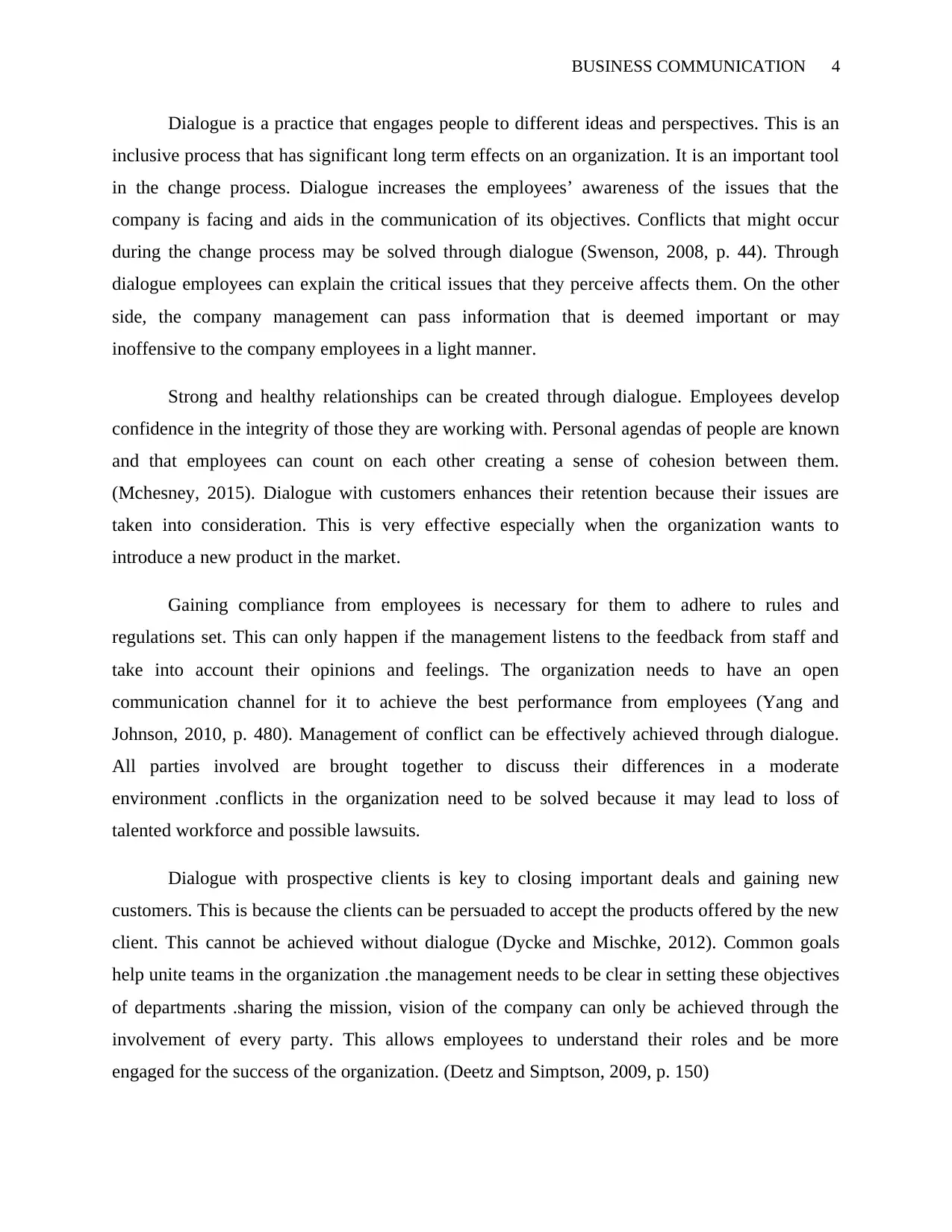
BUSINESS COMMUNICATION 4
Dialogue is a practice that engages people to different ideas and perspectives. This is an
inclusive process that has significant long term effects on an organization. It is an important tool
in the change process. Dialogue increases the employees’ awareness of the issues that the
company is facing and aids in the communication of its objectives. Conflicts that might occur
during the change process may be solved through dialogue (Swenson, 2008, p. 44). Through
dialogue employees can explain the critical issues that they perceive affects them. On the other
side, the company management can pass information that is deemed important or may
inoffensive to the company employees in a light manner.
Strong and healthy relationships can be created through dialogue. Employees develop
confidence in the integrity of those they are working with. Personal agendas of people are known
and that employees can count on each other creating a sense of cohesion between them.
(Mchesney, 2015). Dialogue with customers enhances their retention because their issues are
taken into consideration. This is very effective especially when the organization wants to
introduce a new product in the market.
Gaining compliance from employees is necessary for them to adhere to rules and
regulations set. This can only happen if the management listens to the feedback from staff and
take into account their opinions and feelings. The organization needs to have an open
communication channel for it to achieve the best performance from employees (Yang and
Johnson, 2010, p. 480). Management of conflict can be effectively achieved through dialogue.
All parties involved are brought together to discuss their differences in a moderate
environment .conflicts in the organization need to be solved because it may lead to loss of
talented workforce and possible lawsuits.
Dialogue with prospective clients is key to closing important deals and gaining new
customers. This is because the clients can be persuaded to accept the products offered by the new
client. This cannot be achieved without dialogue (Dycke and Mischke, 2012). Common goals
help unite teams in the organization .the management needs to be clear in setting these objectives
of departments .sharing the mission, vision of the company can only be achieved through the
involvement of every party. This allows employees to understand their roles and be more
engaged for the success of the organization. (Deetz and Simptson, 2009, p. 150)
Dialogue is a practice that engages people to different ideas and perspectives. This is an
inclusive process that has significant long term effects on an organization. It is an important tool
in the change process. Dialogue increases the employees’ awareness of the issues that the
company is facing and aids in the communication of its objectives. Conflicts that might occur
during the change process may be solved through dialogue (Swenson, 2008, p. 44). Through
dialogue employees can explain the critical issues that they perceive affects them. On the other
side, the company management can pass information that is deemed important or may
inoffensive to the company employees in a light manner.
Strong and healthy relationships can be created through dialogue. Employees develop
confidence in the integrity of those they are working with. Personal agendas of people are known
and that employees can count on each other creating a sense of cohesion between them.
(Mchesney, 2015). Dialogue with customers enhances their retention because their issues are
taken into consideration. This is very effective especially when the organization wants to
introduce a new product in the market.
Gaining compliance from employees is necessary for them to adhere to rules and
regulations set. This can only happen if the management listens to the feedback from staff and
take into account their opinions and feelings. The organization needs to have an open
communication channel for it to achieve the best performance from employees (Yang and
Johnson, 2010, p. 480). Management of conflict can be effectively achieved through dialogue.
All parties involved are brought together to discuss their differences in a moderate
environment .conflicts in the organization need to be solved because it may lead to loss of
talented workforce and possible lawsuits.
Dialogue with prospective clients is key to closing important deals and gaining new
customers. This is because the clients can be persuaded to accept the products offered by the new
client. This cannot be achieved without dialogue (Dycke and Mischke, 2012). Common goals
help unite teams in the organization .the management needs to be clear in setting these objectives
of departments .sharing the mission, vision of the company can only be achieved through the
involvement of every party. This allows employees to understand their roles and be more
engaged for the success of the organization. (Deetz and Simptson, 2009, p. 150)
Paraphrase This Document
Need a fresh take? Get an instant paraphrase of this document with our AI Paraphraser
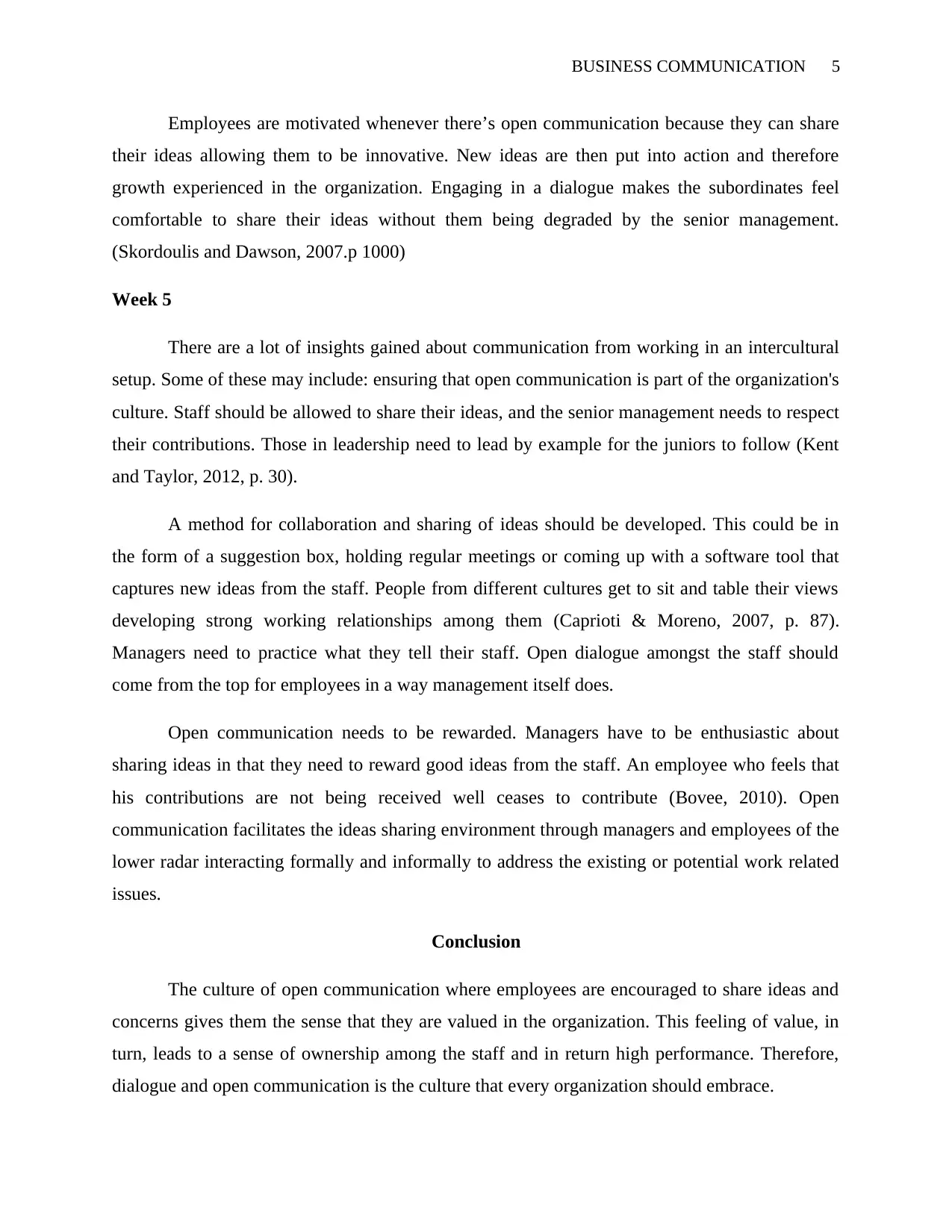
BUSINESS COMMUNICATION 5
Employees are motivated whenever there’s open communication because they can share
their ideas allowing them to be innovative. New ideas are then put into action and therefore
growth experienced in the organization. Engaging in a dialogue makes the subordinates feel
comfortable to share their ideas without them being degraded by the senior management.
(Skordoulis and Dawson, 2007.p 1000)
Week 5
There are a lot of insights gained about communication from working in an intercultural
setup. Some of these may include: ensuring that open communication is part of the organization's
culture. Staff should be allowed to share their ideas, and the senior management needs to respect
their contributions. Those in leadership need to lead by example for the juniors to follow (Kent
and Taylor, 2012, p. 30).
A method for collaboration and sharing of ideas should be developed. This could be in
the form of a suggestion box, holding regular meetings or coming up with a software tool that
captures new ideas from the staff. People from different cultures get to sit and table their views
developing strong working relationships among them (Caprioti & Moreno, 2007, p. 87).
Managers need to practice what they tell their staff. Open dialogue amongst the staff should
come from the top for employees in a way management itself does.
Open communication needs to be rewarded. Managers have to be enthusiastic about
sharing ideas in that they need to reward good ideas from the staff. An employee who feels that
his contributions are not being received well ceases to contribute (Bovee, 2010). Open
communication facilitates the ideas sharing environment through managers and employees of the
lower radar interacting formally and informally to address the existing or potential work related
issues.
Conclusion
The culture of open communication where employees are encouraged to share ideas and
concerns gives them the sense that they are valued in the organization. This feeling of value, in
turn, leads to a sense of ownership among the staff and in return high performance. Therefore,
dialogue and open communication is the culture that every organization should embrace.
Employees are motivated whenever there’s open communication because they can share
their ideas allowing them to be innovative. New ideas are then put into action and therefore
growth experienced in the organization. Engaging in a dialogue makes the subordinates feel
comfortable to share their ideas without them being degraded by the senior management.
(Skordoulis and Dawson, 2007.p 1000)
Week 5
There are a lot of insights gained about communication from working in an intercultural
setup. Some of these may include: ensuring that open communication is part of the organization's
culture. Staff should be allowed to share their ideas, and the senior management needs to respect
their contributions. Those in leadership need to lead by example for the juniors to follow (Kent
and Taylor, 2012, p. 30).
A method for collaboration and sharing of ideas should be developed. This could be in
the form of a suggestion box, holding regular meetings or coming up with a software tool that
captures new ideas from the staff. People from different cultures get to sit and table their views
developing strong working relationships among them (Caprioti & Moreno, 2007, p. 87).
Managers need to practice what they tell their staff. Open dialogue amongst the staff should
come from the top for employees in a way management itself does.
Open communication needs to be rewarded. Managers have to be enthusiastic about
sharing ideas in that they need to reward good ideas from the staff. An employee who feels that
his contributions are not being received well ceases to contribute (Bovee, 2010). Open
communication facilitates the ideas sharing environment through managers and employees of the
lower radar interacting formally and informally to address the existing or potential work related
issues.
Conclusion
The culture of open communication where employees are encouraged to share ideas and
concerns gives them the sense that they are valued in the organization. This feeling of value, in
turn, leads to a sense of ownership among the staff and in return high performance. Therefore,
dialogue and open communication is the culture that every organization should embrace.
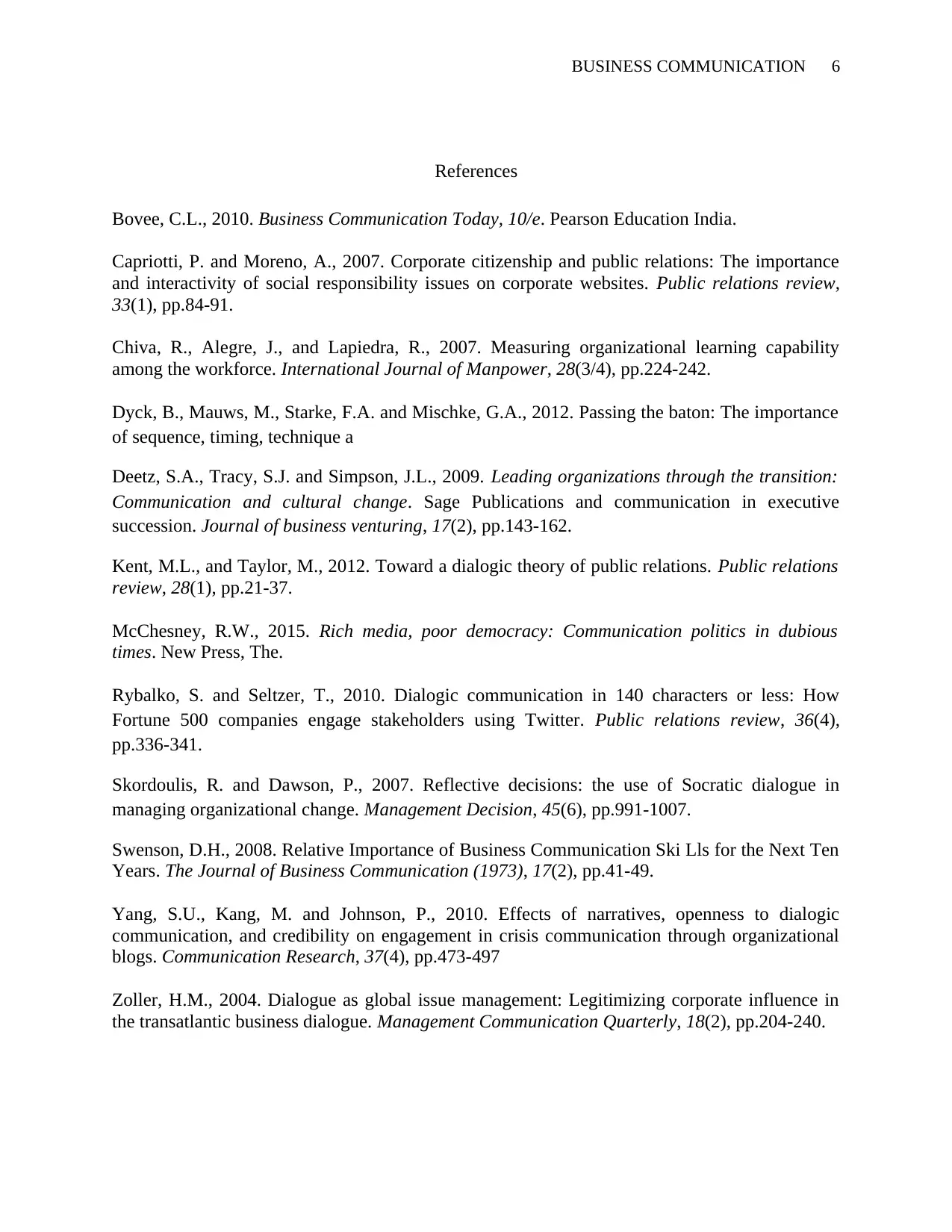
BUSINESS COMMUNICATION 6
References
Bovee, C.L., 2010. Business Communication Today, 10/e. Pearson Education India.
Capriotti, P. and Moreno, A., 2007. Corporate citizenship and public relations: The importance
and interactivity of social responsibility issues on corporate websites. Public relations review,
33(1), pp.84-91.
Chiva, R., Alegre, J., and Lapiedra, R., 2007. Measuring organizational learning capability
among the workforce. International Journal of Manpower, 28(3/4), pp.224-242.
Dyck, B., Mauws, M., Starke, F.A. and Mischke, G.A., 2012. Passing the baton: The importance
of sequence, timing, technique a
Deetz, S.A., Tracy, S.J. and Simpson, J.L., 2009. Leading organizations through the transition:
Communication and cultural change. Sage Publications and communication in executive
succession. Journal of business venturing, 17(2), pp.143-162.
Kent, M.L., and Taylor, M., 2012. Toward a dialogic theory of public relations. Public relations
review, 28(1), pp.21-37.
McChesney, R.W., 2015. Rich media, poor democracy: Communication politics in dubious
times. New Press, The.
Rybalko, S. and Seltzer, T., 2010. Dialogic communication in 140 characters or less: How
Fortune 500 companies engage stakeholders using Twitter. Public relations review, 36(4),
pp.336-341.
Skordoulis, R. and Dawson, P., 2007. Reflective decisions: the use of Socratic dialogue in
managing organizational change. Management Decision, 45(6), pp.991-1007.
Swenson, D.H., 2008. Relative Importance of Business Communication Ski Lls for the Next Ten
Years. The Journal of Business Communication (1973), 17(2), pp.41-49.
Yang, S.U., Kang, M. and Johnson, P., 2010. Effects of narratives, openness to dialogic
communication, and credibility on engagement in crisis communication through organizational
blogs. Communication Research, 37(4), pp.473-497
Zoller, H.M., 2004. Dialogue as global issue management: Legitimizing corporate influence in
the transatlantic business dialogue. Management Communication Quarterly, 18(2), pp.204-240.
References
Bovee, C.L., 2010. Business Communication Today, 10/e. Pearson Education India.
Capriotti, P. and Moreno, A., 2007. Corporate citizenship and public relations: The importance
and interactivity of social responsibility issues on corporate websites. Public relations review,
33(1), pp.84-91.
Chiva, R., Alegre, J., and Lapiedra, R., 2007. Measuring organizational learning capability
among the workforce. International Journal of Manpower, 28(3/4), pp.224-242.
Dyck, B., Mauws, M., Starke, F.A. and Mischke, G.A., 2012. Passing the baton: The importance
of sequence, timing, technique a
Deetz, S.A., Tracy, S.J. and Simpson, J.L., 2009. Leading organizations through the transition:
Communication and cultural change. Sage Publications and communication in executive
succession. Journal of business venturing, 17(2), pp.143-162.
Kent, M.L., and Taylor, M., 2012. Toward a dialogic theory of public relations. Public relations
review, 28(1), pp.21-37.
McChesney, R.W., 2015. Rich media, poor democracy: Communication politics in dubious
times. New Press, The.
Rybalko, S. and Seltzer, T., 2010. Dialogic communication in 140 characters or less: How
Fortune 500 companies engage stakeholders using Twitter. Public relations review, 36(4),
pp.336-341.
Skordoulis, R. and Dawson, P., 2007. Reflective decisions: the use of Socratic dialogue in
managing organizational change. Management Decision, 45(6), pp.991-1007.
Swenson, D.H., 2008. Relative Importance of Business Communication Ski Lls for the Next Ten
Years. The Journal of Business Communication (1973), 17(2), pp.41-49.
Yang, S.U., Kang, M. and Johnson, P., 2010. Effects of narratives, openness to dialogic
communication, and credibility on engagement in crisis communication through organizational
blogs. Communication Research, 37(4), pp.473-497
Zoller, H.M., 2004. Dialogue as global issue management: Legitimizing corporate influence in
the transatlantic business dialogue. Management Communication Quarterly, 18(2), pp.204-240.
⊘ This is a preview!⊘
Do you want full access?
Subscribe today to unlock all pages.

Trusted by 1+ million students worldwide

BUSINESS COMMUNICATION 7
1 out of 7
Related Documents
Your All-in-One AI-Powered Toolkit for Academic Success.
+13062052269
info@desklib.com
Available 24*7 on WhatsApp / Email
![[object Object]](/_next/static/media/star-bottom.7253800d.svg)
Unlock your academic potential
Copyright © 2020–2025 A2Z Services. All Rights Reserved. Developed and managed by ZUCOL.



